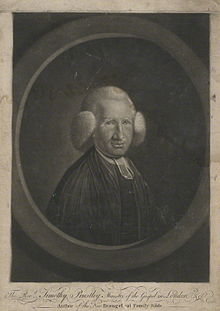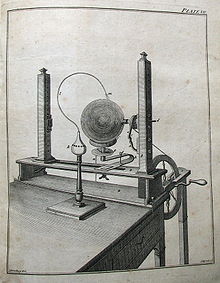Timothy Priestley (19 June 1734 – 23 April 1814) was an English Independent minister. The younger brother of Joseph Priestley, he was a collaborator in making electrical apparatus.

Life
The second child of Jonas and Mary Priestley, was born at Fieldhead in the parish of Birstall, Yorkshire, on 19 June 1734. He was brought up by his grandfather, Joseph Swift, and sent to school at Batley. For some time he was employed in his father's business as a cloth-dresser. [1]
His elder brother Joseph Priestley, thought Timothy frivolous; but he received a religious direction from James Scott (1710-1783), who became minister of Upper Chapel, Heckmondwike in Yorkshire, in 1754. Scott in 1756 established a dissenting academy at Southfield, near Heckmondwike, and Timothy Priestley was the second young man who entered it as a student for the ministry. He got into trouble, however, by going out to preach without leave; and Joseph disparaged his training. [1]
Timothy Priestley's preaching was popular, and he was employed in mission work at Ilkeston, Derbyshire, and elsewhere. In 1760 he was ordained pastor of the congregation at Kipping (later Kipping Chapel, Thornton), near Bradford, Yorkshire: an uncomfortable settlement because the owner of the Kipping estate having ceased to be in sympathy with nonconformity. Early in 1766 Priestley became minister of Hunter's Croft congregational church, Manchester, succeeding to the congregation of Caleb Warhurst. His chapel was enlarged during his ministry, where he was reputed for preaching and also eccentricity in the pulpit. Priestley was accused of "irregularities" amounting to trading to increase his salary, for example participation in "the liquor business" and making packing-cases on Sunday nights (he said he never began till the clock struck twelve). [1] [2]
Priestley refused to join the petitions (1772-3) for relaxation of the Toleration Act, except on the condition that concealment of heresy should be made a capital offence. In 1774 he was in London, preaching at Whitefield's Tabernacle, Moorfields. In 1782 the two Priestleys were appointed to preach the "double lecture" (24 August) at Oldbury, Worcestershire; Joseph wished his brother to decline, and on his refusal to give way, himself withdrew, his place being taken by Habakkuk Crabb. [1]
Priestley's Manchester ministry terminated in his formal dismissal on 14 April 1784, only two hands being held up in his favour. He moved to Dublin, where he remained about two years. He then received a call to succeed Richard Woodgate (d. 28 June 1787) as minister of Jewin Street independent church, London. Here he remained till his death. [1]
Priestley died at Islington on 23 April 1814, and was buried at Bunhill Fields on 29 April. His funeral sermon was preached by George Burder.
Scientific apparatus
Timothy Priestley made electrical machines for sale, under Joseph's directions, and constructed for his brother an electrical kite, 6 feet 4 inches wide, which folded up so as to be carried like a fishing-rod. [1] This kite was mentioned by Joseph in his correspondence with John Canton. [3] The electrical collaboration dated back to Joseph's vacations from Daventry Academy, when the brothers studied science together from encyclopedias, for example the Dictionary of Arts and Sciences of John Barrow. They worked on electrostatics, discharging electrical charges through iron. The machine design was for electrostatic purposes, and Timothy had lathe and other skills for the actual construction. [4]

A market for these machines was created by Joseph's History and Present State of Electricity (1767). [5] Design details were given in John Imison's The School of Arts (1785), [6] and later in the Encyclopædia Britannica. [7]
One such machine survived and was put on display in 1860 at Burlington House by James Yates, part of a display of Priestley memorabilia. It had been bequeathed by Dr. Robert Cappe to John Bostock. [8] Cappe's machine was bought for therapeutic purposes at Leeds General Infirmary, where William Hey supported the treatment; Timothy Priestley was paid £5 11s. 6d. for it. [9]
Works
Priestley issued a periodical, The Christian's Magazine, or Gospel Repository, designed to counteract Unitarianism (three volumes, 1790-2); the first volume is dedicated to Selina, Countess of Huntingdon, a friend. It contained a biography of Scott, his tutor, which was reprinted in 1791. [1]
On his brother Joseph's death he preached at Jewin Street, 29 April 1804, and printed (1804) a funeral sermon, with appendix of anecdotes, the authenticity of some of which has been disputed. [1] The sermon was designed to vindicate his own Calvinistic Methodism. The elder John Aikin was the subject of one of these anecdotes, and the scene painted, which was disputed by John Aikin the son, has been likened to a Methodist conversion narrative. [10]
His advertised Animadversions on his brother's theological views do not seem to have been published. [1] Their differences are known from letters Timothy wrote to their Aunt Sarah. [11]
He published also: [1]
- an annotated Family Bible, 1793?; 1804, 2 vols (the commentary that of The Christian's New and Complete Universal Family Bible of c. 1790); [12]
- the Christian's Looking-Glass, 1790-2;
- Family Exercises, 1792;
and a few single sermons.
Priestley was attacked by the polemicist William Huntington. [13] [14]
Family
Priestley's wife Anne died in 1793 at age 47. [15] His son William (1768-1827) was independent minister at Fordingbridge, Hampshire. [1]
References
- ^ a b c d e f g h i j k . Dictionary of National Biography. London: Smith, Elder & Co. 1885–1900.
- ^ John Stoughton, History of religion in England from the opening of the Long Parliament to the end of the eighteenth century vol. 6 (1882), p. 343; archive.org.
- ^ Robert E. Schofield (1 October 1997). The Enlightenment of Joseph Priestley: A Study of His Life and Work from 1733 to 1773. Penn State Press. p. 142. ISBN 978-0-271-02510-0. Retrieved 28 October 2012.
- ^ Tony Rail (editor), Joseph Priestley's Melanchton to Martin Luther, Kastell (2010), pp. xiii–xiv; archive.org.
- ^ Isabel Rivers and David L. Wykes (editors), Joseph Priestley: Scientist, Philosopher and Theologian (2008), Oxford University Press, pp. 53–4.
- ^ John Imison (1796). The school of arts; or, an introduction to useful knowledge. p. 49. Retrieved 28 October 2012.
- ^ Encyclopædia Britannica; or A dictionary of arts, sciences, and miscellaneous literature. Printed for Archibald Constable and Company. 1823. p. 661. Retrieved 28 October 2012.
- ^ Mary Ellen Bowden; Lisa Rosner (1 July 2005). Joseph Priestley, Radical Thinker: A Catalogue to Accompany the Exhibit at the Chemical Heritage Foundation Commemorating the 200th Anniversary of the Death of Joseph Priestley: 23 August 2004 to 29 July 2005. Chemical Heritage Foundation. p. 38. ISBN 978-0-941901-38-3. Retrieved 28 October 2012.
- ^ W. D. A. Smith, Under the Influence: A history of nitrous oxide and oxygen anaesthesia, Macmillan (1982), p. 7.
- ^ William McCarthy, Anna Letitia Barbauld: Voice of the Enlightenment, Johns Hopkins University Press (2008), note 48 pp. 563–4.
- ^ Neeley, Kathleen L.; Bashore, M. Andrea (2005). "Esteem, regard, and respect for rationality: Joseph Priestley's female connections" (PDF). Bull. Hist. Chem. 30 (2): 77–90.
- ^ Mary Wilson Carpenter (2003). Imperial Bibles, Domestic Bodies: Women, Sexuality, and Religion in the Victorian Market. Ohio University Press. p. 159. ISBN 978-0-8214-1515-3. Retrieved 29 October 2012.
-
^ Brant, Clare.
Oxford Dictionary of National Biography (online ed.). Oxford University Press.
doi:
10.1093/ref:odnb/14243.
{{ cite encyclopedia}}: Missing or empty|title=( help) (Subscription or UK public library membership required.) - ^ William Huntington (May 2010). The Barber; Or, Timothy Priestley Shaved, As Reflected from His Own Looking Glass the Operator William Huntington, S S. BiblioBazaar. ISBN 978-1-170-62847-8. Retrieved 28 October 2012.
- ^ Alfred W. Light, Bunhill Fields (1913), p. 202; archive.org.
- Attribution
![]() This article incorporates text from a publication now in the
public domain: "
Priestley, Timothy".
Dictionary of National Biography. London: Smith, Elder & Co. 1885–1900.
This article incorporates text from a publication now in the
public domain: "
Priestley, Timothy".
Dictionary of National Biography. London: Smith, Elder & Co. 1885–1900.